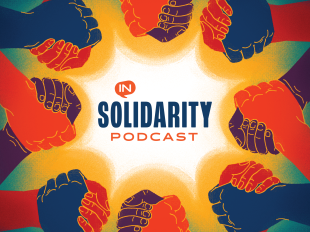About the Racial Wealth Building Curated Strategy List

The Racial Wealth Building Curated Strategy List features evidence-informed strategies to close the racial wealth divide. These solutions account for historical practices that established and maintain the wealth divide– and reduce wealth inequities by increasing income and assets, expanding employment opportunities, removing barriers to quality education, and increasing access to homeownership.
Explore the curated list here.
What is economic wealth?
Economic wealth is the total value of a household’s income and assets, including investments, a home, and any other owned real estate, minus any debts. It accumulates over time and is often passed from one generation to the next. Wealth is more difficult to measure than income but is a better indicator of a household’s resources and ability to withstand emergencies and financial setbacks such as illnesses, accidents, job losses, or unexpected housing expenses. Wealth increases access to opportunities like higher education, retirement, and business ownership. It also provides the collateral necessary to take risks to gain more wealth through investments and entrepreneurship. Individual and household wealth impacts the overall health and wealth of communities. Community wealth is associated with community resilience, meaning how well communities can withstand shocks, such as climate-related disasters.1,2
What is the racial wealth divide and why does it exist?
The racial wealth divide, also called the racial wealth gap, refers to financial disparities between families from different racial, ethnic, or Native backgrounds. White families have significantly greater wealth than families identifying as any other group whether Black, Hispanic, Asian, multi-racial, American Indian, Alaska Native, or any other background, and the divide is growing. For example, the Federal Reserve’s 2016 survey suggests white households have ten times the wealth of Black households. In the highest income quintile (i.e. five equal groups) white households have more than three times the wealth of Black households. In the lowest income quintile, white households have about 400 times the wealth of Black households.1,3,4
The racial wealth divide began with the forced relocation and genocide of Native communities by settlers and through federal government policy and continued with the exploitation of slave labor that fueled the US economy for all states.5 This generated wealth for white people at the expense of people of color. After emancipation, people of color who accumulated some wealth repeatedly had it stripped from them through government action or violence. For example, discriminatory housing, lending, and exclusionary zoning policies were explicit in the Jim Crow era.6,7 The twentieth century has thousands of examples of riots, destruction, and violence against Black communities in which people were killed and homes, businesses, and communities were destroyed.8
Individual efforts alone cannot overcome the structural barriers that maintain the racial wealth divide. Structural barriers include laws, policies, institutional practices, and economic arrangements that create unequal conditions. Employment and wage discrimination further entrench the divide, as do discriminatory tax codes, credit exclusion, and loan denial. In addition, residential segregation increases racial disparities in housing stability, homeownership, and property values.9
A significant part of the racial wealth divide at all income levels is related to lower rates of homeownership and lower home values among people of color.7,9 Structural racism in the housing market created undervalued, marginalized neighborhoods with under-resourced, lower-quality schools, inadequate housing, fewer job opportunities, limited services, deficient food supplies, and neglected public infrastructure.9 Schools in these neighborhoods receive billions of dollars less than schools in predominantly white neighborhoods, since school funding is largely based on local property tax collections.10 By reducing education and employment opportunities, residential segregation prevents socioeconomic mobility, preserves wage gaps, supports the racial wealth divide, and keeps generations in poverty.11 Persistent structural racism has diminished government efforts to address the racial wealth gap through programs that encourage homeownership or higher education. People of color also receive significantly lower returns on their investments in education, stocks, and business than white people.2,12,13,14,15,16
What is the connection between wealth and health?
Higher levels of wealth are associated with better health outcomes, from self-rated health and well-being to lower morbidity and mortality rates. Wealth influences opportunities for employment, housing, health care, and education, all of which contribute to health inequities. The association between wealth and health is not perfect; wealth does not prevent individuals or families from experiencing discrimination and racism. However, research shows that income inequality has a negative effect on overall population health. Economically unequal societies often have higher rates of physical and mental illness, violence, and incarceration. In most countries, income inequality and wealth gaps continue to increase. Wealth is also closely tied to power—the ability to influence priorities, decision-making, and narratives— and together wealth and power influence health and shape economic and health inequalities.10,17,18,19,20
How do you identify solutions that support closing the racial wealth gap?
To close racial wealth divides, communities can start by identifying and dismantling structural racism and discriminatory practices that established and maintain the gap. Communities can support inclusive decision-making and implementation processes around shared priorities. A comprehensive array of strategies is needed to support wealth building and asset development including opportunities for entrepreneurship, income and employment, housing stability and homeownership. Some strategies protect individuals and communities from financial harm, including by improving social insurance --- tax-funded programs that governments administer --- which provide a buffer during financial shocks and major life changes. Other strategies address community wealth building and community asset development to benefit specific groups of people.2,19
References
- Braveman P, Acker J, Arkin E, Proctor D, Gillman A, McGeary KA, Mallya G. Wealth matters for health equity. Robert Wood Johnson Foundation, Achieving Health Equity: An RWJF Collection; 2018. https://www.rwjf.org/en/library/research/2018/09/wealth-matters-for-health-equity.html
- Collins C, Hamilton D, Asante-Muhammad D, Hoxie J. Ten solutions to bridge the racial wealth divide. National Community Reinvestment Coalition, Kirwan Institute for the Study of Race and Ethnicity, Institute for Policy Studies, Inequality.org; 2019. https://ips-dc.org/wp-content/uploads/2019/04/Ten-Solutions-to-Bridge-the-Racial-Wealth-Divide-FINAL-.pdf
- Bhutta N, Chang A, Dettling L, Hsu JW. Disparities in wealth by race and ethnicity in the 2019 survey of consumer finances. Board of Governors of the Federal Reserve System. FEDS Notes; 2020. https://www.federalreserve.gov/econres/notes/feds-notes/disparities-in-wealth-by-race-and-ethnicity-in-the-2019-survey-of-consumer-finances-20200928.htm
- Pollack CE, Chideya S, Cubbin C, Williams B, Dekker M, Braveman P. Should health studies measure wealth?: A systematic review. American Journal of Preventive Medicine. 2007;33(3):250-264. https://www.sciencedirect.com/science/article/abs/pii/S0749379707003145
- Asante-Muhammed D, Kamra E, Sanchez C, Ramirez K, Tec R. Racial wealth snapshot: Native Americans. National Community Reinvestment Coalition. February 14, 2022. https://ncrc.org/racial-wealth-snapshot-native-americans/
- Quick K, Kahlenberg RD. Attacking the Black-white opportunity gap that comes from residential segregation. Washington, DC: The Century Foundation; 2019. https://tcf.org/content/report/attacking-black-white-opportunity-gap-comes-residential-segregation/?agreed=1
- Kaplan J, Valls A. Housing discrimination as a basis for Black reparations. Public Affairs Quarterly. 2007;21(3):255-273. https://www.jstor.org/stable/40441462?seq=1
- Craemer T, Smith T, Harrison B, et al. Wealth implications of slavery and racial discrimination for African American descendants of the enslaved. The Review of Black Political Economy. 2020;47(3):218-254. https://journals.sagepub.com/doi/abs/10.1177/0034644620926516?journalCode=rbpa
- Haberle M, House S, eds. Racial justice in housing finance: A series on new directions. Washington, DC: Poverty & Race Research Action Council (PRRAC); 2021. https://www.prrac.org/racial-justice-in-housing-finance-series-2021/
- Ray R, Perry AM, Harshbarger D, Elizondo S, Gibbons A. Homeownership, racial segregation, and policy solutions to racial wealth equity. Washington, DC: Brookings Institution; 2021. https://www.brookings.edu/essay/homeownership-racial-segregation-and-policies-for-racial-wealth-equity/
- Williams DR, Collins C. Reparations: A viable strategy to address the enigma of African American health. American Behavioral Scientist. 2004;47(7):977-1000. https://scholar.harvard.edu/davidrwilliams/dwilliam/publications/reparations-viable-strategy-address-enigma-african-american-health
- Boerma J, Karabarbounis L. Reparations and persistent racial wealth gaps. National Bureau of Economic Research: NBER Working Paper 28468. 2021. https://www.nber.org/system/files/working_papers/w28468/w28468.pdf
- Herring C, Henderson L. Wealth inequality in Black and white: Cultural and structural sources of the racial wealth gap. Race and Social Problems. 2016;8:4-17. https://link.springer.com/article/10.1007/s12552-016-9159-8
- Hamilton D, Darity W. The political economy of education, financial literacy, and the racial wealth gap. Federal Reserve Bank of St. Louis Review. 2017;99(1):59-76. https://files.stlouisfed.org/files/htdocs/publications/review/2017-02-15/the-political-economy-of-education-financial-literacy-and-the-racial-wealth-gap.pdf
- Strickland R. Osage oil: Mineral law, murder, mayhem, and manipulation. Natural Resources & Environment. 1995;10(1):39-43. https://www.jstor.org/stable/40923431
- Tulsa Historical Society and Museum. 1921 Tulsa Race Massacre. https://www.tulsahistory.org/exhibit/1921-tulsa-race-massacre/
- Hajat A, Kaufman JS, Rose KM, Siddiqi A, Thomas JC. Long-term effects of wealth on mortality and self-rated health status. American Journal of Epidemiology. 2011;173(2):192-200. https://academic.oup.com/aje/article/173/2/192/99467
- Pickett KE, Wilkinson RG. Income inequality and health: A causal review. Social Science & Medicine. 2015;128:316-326. https://www.sciencedirect.com/science/article/pii/S0277953614008399
- Nowatzki NR. Wealth inequality and health: A political economy perspective. International Journal of Health Services. 2012;42(3):403-424. https://journals.sagepub.com/doi/10.2190/HS.42.3.c
- McCartney G, Dickie E, Escobar O, Collins C. Health inequalities, fundamental causes and power: towards the practice of good theory. Sociology of Health & Illness. 2020;43(1):20-39. https://onlinelibrary.wiley.com/doi/full/10.1111/1467-9566.13181


